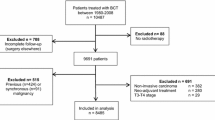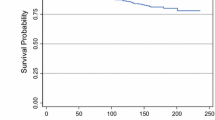Abstract
Background
Young women have worse outcome following breast-conserving therapy (BCT) than do older patients in many studies. We examined how clinical, pathological, and treatment factors affect these results.
Methods
Between 1993 and 1999, 130 patients age 40 years or younger with stage I or II breast cancer were treated with BCT. The median radiation dose to the tumor bed was 61 Gy; 80% of patients received chemotherapy; and 29% of 72 patients with estrogen-receptor positive tumors received tamoxifen. Median follow-up was 93 months.
Results
Fifteen patients (12%) developed an ipsilateral breast tumor recurrence (IBTR), with or without other simultaneous failure sites. The Kaplan-Meier 5- and 8-year actuarial rates were 8% and 14%, respectively. The 74 patients with grade 3 tumors had a higher IBTR rate (8-year actuarial rate, 18%) than the 54 patients with grade 1–2 lesions (7%) (P = 0.09). Six patients developed contralateral breast cancers, and 17 developed distant metastases (DM). The 8-year actuarial rates for freedom-from-DM, relapse-free survival, and overall survival were 85%, 72% and 96%, respectively.
Conclusion
This represents one of the largest series of young women treated with BCT, using an approach similar to current practice. The IBTR rate was substantially lower than in many past studies, but still higher than would be expected for older women. This appeared largely due to the increased rate of IBTR in patients with grade 3 tumors. If this observation is confirmed, further analysis of this subgroup may lead to ways of reducing the risk of IBTR.
Similar content being viewed by others
Abbreviations
- EIC:
-
Extensive intraductal component
- LVI:
-
Lymphovascular invasion
- ER:
-
Estrogen receptor protein
- RT:
-
Radiation therapy
References
Nixon AJ, Neuberg D, Hayes DF (1994) Relationship of patient age to pathologic features of the tumor and prognosis for patients with stage I or II breast cancers. J Clin Oncol 12:888–894
Albain KS, Allred DC, Clark GM (1994) Breast cancer outcome and predictors of outcome: are there age differentials? J Natl Cancer Inst Monogr 16:35–42
Agrup M, Stal O, Olsen K, Wingren S (2000) C-erbB-2 overexpression and survival in early onset breast cancer. Breast Cancer Res Treat 63:23–29
Marcus JN, Watson P, Page DL, et al (1994) Pathology and heredity of breast cancer in younger women. J Natl Cancer Inst Monogr 16:23–34
de la Rochefordiere A, Asselain B, Campana F, et al (1993) Age as prognostic factor in premenopausal breast carcinoma. Lancet 341:1039–1043
Aebi S, Gelber S, Castiglione-Gertsch M, et al (2000) Is chemotherapy alone adequate for young women with estrogen-receptor-positive breast cancer? Lancet 355:1869–1874
Zhou P, Recht A (2004) Young age and outcome for women with early-stage invasive breast carcinoma. Cancer 101:1264–1274
Greene FL, Page DL, Fleming IA et al (eds) (2002) AJCC Cancer Staging Manual, 6th Edn. New York, Springer
Elston CW, Ellis IO (1991) Pathological prognostic factors in breast cancer. I. The value of histological grade in breast cancer: experience from a large study with long-term follow-up. Histopathol 19:403–410
Schnitt SJ, Connolly JL (1992) Processing and evaluation of breast excision specimens: a clinically oriented approach. Am J Clin Pathol 98:125–137
Schnitt SJ, Abner A, Gelman R, et al (1994) The relationship between microscopic margins of resection and the risk of local recurrence in patients with breast cancer treated with breast-conserving surgery and radiation therapy. Cancer 74:1746–1751
Nixon A, Schnitt S, Connolly JL et al (1992) Relationship of patient age to pathologic features of the tumor and the risk of local recurrence for patients with stage I or II breast cancer treated with conservative surgery and radiation therapy. Int J Radiat Oncol Biol Phys 24(suppl 1):221 (abstr)
Kurtz JM, Jacquemier J, Amalric R, et al (1990) Why are local recurrences after breast conserving therapy more frequent in young patients? J Clin Oncol 8:591–598
Vrieling C, Collette L, Fourquet A, et al (2003) Can patient-, treatment- and pathology-related characteristics explain the high local recurrence rate following breast-conserving therapy in young patients? Eur J Cancer 39:932–944
Voogd AC, Nielsen M, Peterse JL, et al (2001) Differences in risk factors for local and distant recurrence after breast-conserving therapy or mastectomy for stage I and II breast cancer: pooled results of two large European randomized trials. J Clin Oncol 19:1688–1697
DiBiase SJ, Komarnicky LT, Schwartz GF, et al (1998) The number of positive margins influences the outcome of women treated with breast preservation for early stage breast carcinoma. Cancer 82:2212–2220
Park CC, Mitsumori M, Nixon A, et al (2000) Outcome at 8 years after breast-conserving surgery and radiation therapy for invasive breast cancer: influence of margin status and systemic therapy on local recurrence. J Clin Oncol 18:1668–1675
Holli K, Isola J (1997) Effect of age on the survival of breast cancer patients. Eur J Cancer 33:425–428
Early Breast Cancer Trialists’ Group (2005) Effects of radiotherapy and of differences in the extent of surgery for early breast cancer on local recurrence and 15-year survival: an overview of the randomised trials. Lancet 366:2087–2106
Kroman N, Holtveg H, Wohlfahrt J, et al (2004) Effect of breast conserving therapy versus radical mastectomy on prognosis for young women with breast carcinoma. Cancer 100:688–693
Fisher B, Anderson S, Bryant J, et al (2002) Twenty-year follow-up of a randomized trial comparing total mastectomy, lumpectomy, and lumpectomy plus radiation for the treatment of invasive breast cancer. N Engl J Med 347:1233–1241
Veronesi U, Cascinelli N, Mariani L, et al (2002) Twenty-year follow up of a randomized study comparing breast conservative surgery with radical mastectomy for early breast cancer. N Engl J Med 347:1227–1232
Sarrazin D, Le MG, Arriagada R, et al (1989) Ten-year results of a randomized trial comparing a conservative treatment to mastectomy in early breast cancer. Radiother Oncol 14:177–184
Jacobson JA, Danforth DN, Cowan KH, et al (1995) Ten-year results of a comparison of conservation with mastectomy in the treatment of stage I and II breast cancer. N Engl J Med 332:907–911
Van Dongen JA, Voogd AC, Fentiman IS, et al (2000) Long-term results of a randomized trial comparing breast-conserving therapy with mastectomy: European Organization for Research and Treatment of Cancer 10801 trial. J Natl Cancer Inst 92:1143–1150
Blichert-Toft M, Rose C, Andersen JA, et al (1992) Danish randomized trial comparing breast conservation therapy with mastectomy: Six years of life-table analysis. J Natl Cancer Inst Monogr 11:19–25
Matthews R, McNeese M, Montague E, et al (1988) Prognostic implications of age in breast cancer patients treated with tumorectomy and irradiation or mastectomy. Int J Radiat Oncol Biol Phys 14:659–663
Bouvet M, Babiera GV, Tucker SL, et al (1997) Does breast conservation therapy in young women with breast cancer adversely affect local disease control and survival rate? The M.D. Anderson Cancer Center Experience. Breast J 3:169–175
Acknowledgements
Support provided by the Joan and Haim Eliachar Endowment Fund for Breast Cancer Research, Department of Radiation Oncology, Beth Israel Deaconess Medical Center, Boston. We also thank Ms. R. Amezquita for her extraordinary administrative support for this project.
Author information
Authors and Affiliations
Corresponding author
Rights and permissions
About this article
Cite this article
Zhou, P., Gautam, S. & Recht, A. Factors Affecting Outcome for Young Women with Early Stage Invasive Breast Cancer Treated with Breast-conserving Therapy. Breast Cancer Res Treat 101, 51–57 (2007). https://doi.org/10.1007/s10549-006-9268-y
Received:
Accepted:
Published:
Issue Date:
DOI: https://doi.org/10.1007/s10549-006-9268-y




